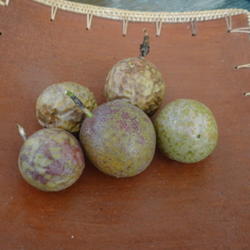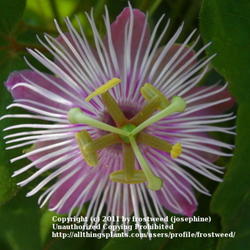Drawings and written descriptions from the late 1500s and early 1600s describe the flowers of Passiflora as portraying the crucifixion of Christ. The name of the genus, Passiflora, comes from the Latin flos meaning "flower" and passio meaning "suffering." The plant habit of the genus includes small shrubs, slender trees and the more commonly known perennial and annual vines. Most are native to South America, growing at various altitudes from jungle to mountainous regions, with a few species native to Asia, Australia, New Zealand, and North America. Over 500 known species and 700 hybrids and cultivars of Passiflora are currently recognized.
The intricate blooms of the passionflower have developed specialized parts to serve the pollinators it desires. While bats, hummingbirds, and a variety of insects are all utilized for the pollination process, the specific pollinator for each passionflower is determined by scent, composition, and acess to the nectar. The flowers grow most commonly as a single bloom from a peduncle originating at a node where the leaf and twining tendril join the stem. At the end of the peduncle is the floral tube where the sepals, petals and corona are attached. The floral tube can be short and saucer shaped in some species or much longer and tube shaped in others. Contained within the bottom cup of the floral tube are the nectary and the area forming the base of the androgynophore or column.
The androgynophore, sometimes referred to as the column, bears the female and male parts of the flower. The ovary sits at the top, and surrounding the base stalk of the ovary is a tube formed by the filaments of the stamens. The filaments continue to extend beneath the ovary to the attached anthers, which will face pollen side downward toward the corona and form a ring as they prepare to open and reveal the pollen. The ovary contains 3 carpels from which 3 styles extend. Each style expands to a nail-shaped end on which the two lobes of the stigma are attached. The styles are upright when the bloom first opens and later bend downward to position themselves for pollination. If pollination is successful a fruit will form.
 |

|
Passionflowers have 5 sepals and 5 petals with the unique exception of Passiflora triloba, which has 6 sepals and 6 petals. Sepals and petals usually are nearly equal in size, with the sepals being of a slightly heavier substance. The tips of the sepals frequently will have a small horn or awn extending from the center line of the sepal segment. The coloring of the sepals and petals is most often the same color or a different shade or tone of the same color, but it can be two completely different colors. The colorful corona, which is often fantastically banded with multiple colors, is the crowning glory of the passionflower.
While the filaments forming the corona are not a part of the sex organs, they do serve several functions. The shortest filaments of the innermost row form a membrane called the operculum, the purpose of which is to protect the nectary from small insects and rain and to prevent the loss of nectar in downward-facing blooms. The outer rows of the corona continue the protection of the nectar close to the androgynophore and the rows farther outward serve to attract the pollinators.
 |
The growing conditions for passionflowers can vary and may depend on the specific needs of the plant when growing in its natural environment. It is always advisable to learn about the needs and growth habit of the specific passionflower you are purchasing. Passionflowers prefer full sun and protection from high winds. The majority of passionflowers will only tolerate temperatures below 50 degrees F/ 10 degrees C for short periods of time, making them the perfect subject for container plants in colder climates. Deciding on a container for planting is a personal choice as it must meet both the needs of the plant and the grower. Passionflowers have rapidly growing roots which will fill a very small pot quickly. Depending on the size of the plant obtained, fresh cuttings should be gradually repotted to larger sizes. A 10-12 inch container is an acceptable size for most passionflowers, allowing room for the growth of the roots, and if it is heavy enough it will aid in preventing the top heavy vines from toppling over in breezy conditions. Hanging baskets can be especially attractive and provide an alternative to the problem of being top heavy and the need to provide some form of support for the vine . However, the vine will continue to try to grow upwards and may cover the support it is hanging from in a tight tangled mass before it begins to drape downward. Another alternative is to plant directly into the ground when temperatures are within the acceptable range. Be sure to provide a trellis or other form of climbing support. The tender passionflowers not able to winter outside can later be carefully dug and potted for overwintering indoors.

|
After you decide on a container for your plant, you will need soil. Most passionflowers will grow and bloom when planted in a quality commercial potting mix. The soil should be light enough to provide good drainage. Waterlogged roots will rot. Correct watering is important for the health of the roots and vine. Avoid keeping them too wet or allowing them to dry out. They must be kept evenly moist. During the overwintering period, however, watering should be moderate. During the growing period, regular fertilizing can aid in health and bloom performance. Passionflowers growing in containers have a higher need for fertilizing than those planted directly into the ground. A high-quality balanced fertilizer can be added at the recommended dosage and in accordance with the manufacturer's instructions. A trellis of some sort will need to be provided after potting. This is another personal choice and will depend on the expected height of your plant. The main stem of the vine itself will not twine or grasp, so the maximum diameter the tendrils are able to grasp must be considered. For a simple support, use three bamboo poles, each 3-4 feet in length, spaced evenly inside the edge of the pot and tied together at the top.
Passionflowers are available through mail order and from specialty greenhouses and growers. Understanding a little of their cultural requirements makes the inclusion of these fragrant, unique flowering vines in your garden or container plantings a delightful experience. Discover the passion of Passiflora.
| Thread Title | Last Reply | Replies |
|---|---|---|
| You've enabled me. by dormantsrule | May 7, 2014 6:31 PM | 4 |
| Passiflora by gardeningal | May 28, 2013 2:50 PM | 0 |
| Excellent article Char by flaflwrgrl | May 25, 2013 9:49 AM | 15 |